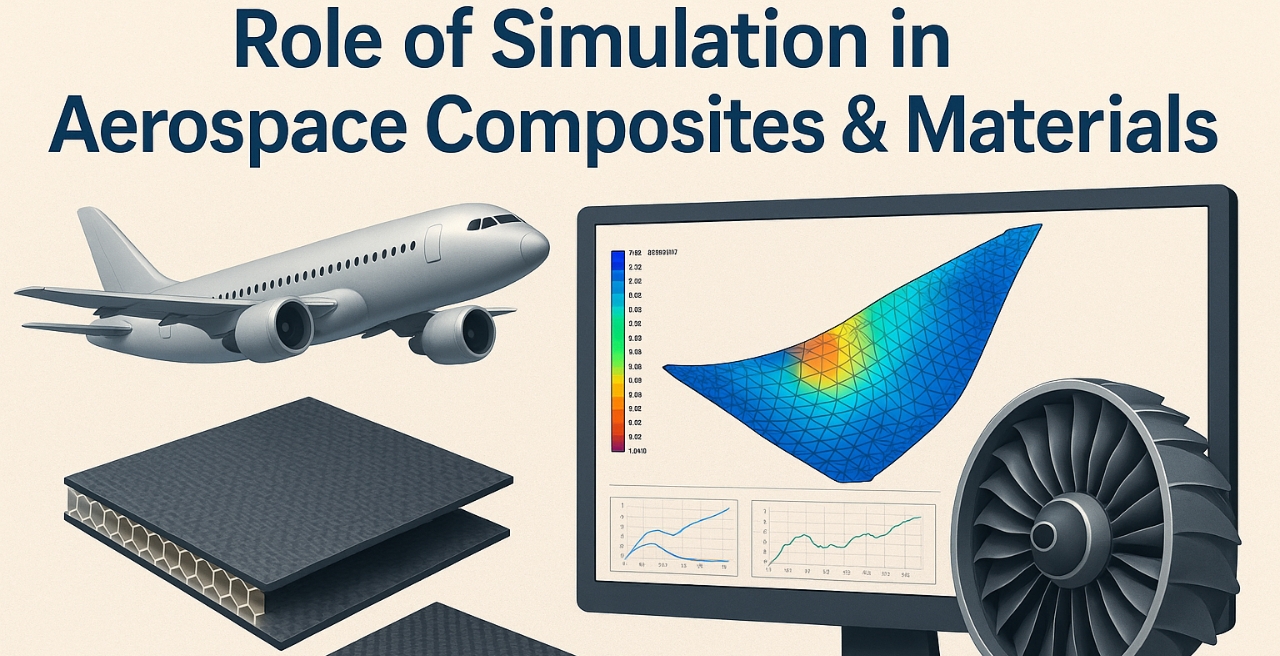The aerospace industry is motivated by the quest to have lighter, stronger and efficient designs. Each new material innovation can change performance, safety and sustainability significantly.
Aerospace engineering has been revolutionized in recent years by the use of composite materials. These materials are lightweight and have superior strength and this has made aircraft to have better fuel efficiency and durability.
However, it is complicated to design using composites. This is where simulation is very important to assist engineers make predictions on material behaviour, cost reduction and speedy innovation.
Why Composites Are Transforming Aerospace
Composites have become essential in contemporary aircraft manufacturing. They are increasingly substituting conventional metals such as aluminium and steel in various structural components.
Key benefits include:
- Light Strength: Improved fuel economy and payload capacity.
- High Durability: Fatigue and corrosion resistant.
- Design Flexibility: Materials can be tailored to specific stress or load requirements.
- Sustainability: Reduction of emissions through lightweight structures.
Fuselage panels, wings, rotor blades and interior components are all made using composites and are therefore necessary in the future aerospace design.
Challenges in Designing with Composites
Although composites have significant performance advantages, they are hard to design and test. They are quite different in their behaviour compared to metals, and the study of the differences is essential to the safety and reliability.
Main challenges include:
- Complex behaviour: nonlinear and anisotropic responses under different loads.
- Manufacturing defects: Problems such as gaps or fiber misalignment can cause failure.
- Difficult failure prediction: multiple modes such as delamination or matrix cracking.
- Environmental effects: Heat, moisture and vibration impact long-term durability.
Tackling these challenges necessitates sophisticated modelling and analysis prior to the commencement of manufacturing.
The Power of Simulation in Aerospace Materials
Simulation has become an essential part of aerospace engineering. This allows teams to study how composites behave under different conditions – long before physical prototypes are built.
Simulation enables engineers to:
- Model fiber orientation and layer sequence accurately.
- Predict a life full of stress, pressure and fatigue in important components.
- Analyze thermal, impact and vibration performance.
- Identify weak points and improve the design early in development.
This helps in saving time and costs in tests and final products can be made to meet the performance and safety standards.
Simulation Tools Driving Innovation
The aerospace engineering of the present day is based on the sophisticated MSC Nastran, Digimat and Abaqus. With such programs, material behaviour can be simulated, both on a micro and macro scale.
Capabilities include:
- Integrating real material data into the simulation environment.
- Perform multi-scale modelling to understand material performance from fibers to complete components.
- Enabling virtual testing and certification before physical manufacturing.
These simulations offer profound understanding of the performance of materials under flight conditions – encompassing extreme heat and pressure as well as prolonged fatigue.
Real-World Impact of Simulation
Throughout the aerospace industry, simulation has proven its value in designing composite materials and components.
Examples include:
- Boeing 787 Dreamliner: Composites are approximately 50 percent. A 20 percent increase in fuel efficiency was realized with the help of simulations.
- Airbus A350 XWB: Depending on virtual tests to design and certify large composite fuselage panels.
- SpaceX and ISRO: Simulation: Model lightweight spacecraft and rocket thermal protection and structures.
These examples show how simulation bridges the gap between design and real-world performance, reducing risks and improving innovation.
The Future: AI and Digital Twins
The forthcoming era of aerospace materials is being influenced by AI-driven design and Digital Twin technology.
Emerging trends include:
- AI-driven material forecasting: Machine learning algorithms facilitate the rapid discovery of novel composite formulations.
- Digital replicas: Real-time digital representations of aircraft components track wear and performance throughout their operational lifespan.
- Collaboration with additive manufacturing: Simulations enhance the optimization of 3D-printed composites prior to production.
These technologies will make design cycles faster, more efficient and more sustainable – redefining the way aerospace materials are developed and tested.
Conclusion
Simulation is redefining how aerospace engineers approach materials and structures. It transforms complex physical testing into precise digital experimentation, saving both time and cost.
By virtually validating composite behaviour, engineers can design lighter, stronger, and safer aircraft – pushing the boundaries of what’s possible in aerospace innovation.
The future of flight will be built not only from advanced materials but also from the power of simulation that shapes them.

















